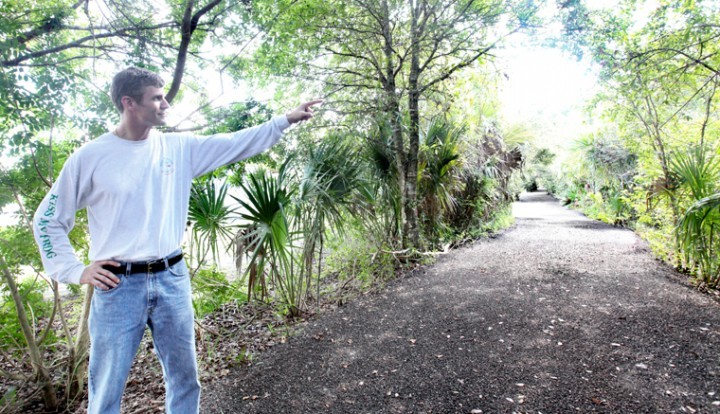FELLSMERE — When the Trans-Florida Central Railroad operated a steam train on what was called the Dinky Line running between Sebastian and the outer edges of Fellsmere in the early 1900s, Interstate 95 wasn’t a barrier – it wasn’t even a glimmer in a civil engineer’s eye.
The Fellsmere Railroad was abandoned more than a half century ago – its train tracks long gone. But 12 miles of the mounded and graded path once traversed by the steam locomotives of the Dinky Line are being converted into trails for hikers and mountain bikers to explore the great outdoors.
And Fellsmere City Manager Jason Nunemaker has been working with county and state officials to get a caged pedestrian overpass built over I-95 to link the east and west legs of the Rails to Trails system and fully connect Sebastian and Fellsmere.
The Rails to Trails project is part of the Indian River County Metropolitan Planning Organization’s overall Greenways Plan published in August 2008.
“Bicycling and pedestrian facilities are increasingly important components of a well-rounded multimodal transportation system. Many people in Indian River County take advantage of favorable weather throughout much of the year by walking and bicycle riding for leisure and mobility.
Providing appropriate facilities can encourage people to make short trips by bicycle or on foot rather than in an automobile, and this helps contribute to a healthy citizenry,” the plan states.
The Rails to Trails project was ranked number one in that plan, with a score of 93 out of 100.
Part of the reason is that, on the busy County Road 512 corridor, automobiles move at a high rate of speed and it’s not very welcoming to pedestrians or cyclists.
Rails to Trails offers transportation alternatives packaged with opportunities for exercise, bird watching and close contact with the native wildlife of the area.
“There is also a safety benefit from providing greenway facilities separated from automobile travel. Currently, bicyclists and pedestrians represent 13 percent of all traffic fatalities, but comprise less than 5 percent of all trips according to 2007 Traffic Safety Facts compiled by the National Highway Traffic Safety Administration. A lack of off-road greenway trails can increase exposure for traffic conflicts,” the MPO study states.
“I used to get out and mountain bike when I was back in Virginia, but there really aren’t a whole lot of opportunities to do that here,” Nunemaker said.
That’s one thing the expansion of Rails to Trails will seek to change in the years ahead.
Hiking and biking trails are possibly not the highest and best use of the old railroad right of way, according to Rich Votapka, author of the book, A Photographic History of Fellsmere, featuring photographs shot and compiled by long-time resident Clarence “Korky” Korker.
Votapka dreams of rebuilding the railroad tracks west of I-95, bringing in a steam train and building a railroad-themed village around it to create a tourist Mecca.
But in the meantime, he’s happy the land has been preserved.
“At least it’s not built over,” said Votapka, who was instrumental in getting historical markers made for the trailheads.
The markers give a brief history of the Fellsmere Railroad.
These enable trail walkers to reflect on all the people and machines and livestock and produce and construction materials that once rode the rails on that same ground.
“There’s a very great historic value to walk over the ground where many trains have traveled,” he said.
Once the legs of the trail are connected, Nunemaker also sees some tourism potential of a different type.
Nunemaker envisions the trail and other connecting facilities as a venue for possibly athletic events that would take advantage of the uniqueness of having the North County Aquatic Center and park, the trail for running or biking and the buffer preserve possibly for kayaking.
“I could see us hosting some kind of extreme sporting event,” Nunemaker said.

